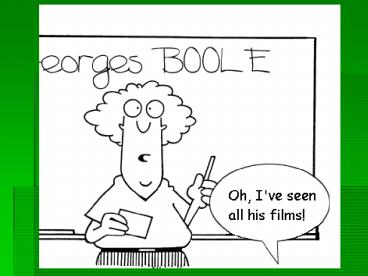John Vincent Atanasoff 1903-1995 - PowerPoint PPT Presentation
Title:
John Vincent Atanasoff 1903-1995
Description:
Thought mechanisms required Zero and place-value system (positional) Development of algebraic thought Development of logical thought From classical logic to algebraic ... – PowerPoint PPT presentation
Number of Views:56
Avg rating:3.0/5.0
Title: John Vincent Atanasoff 1903-1995
1
(No Transcript)
2
Thought mechanisms required
- Zero and place-value system (positional)
- Development of algebraic thought
- Development of logical thought
- From classical logic to algebraic and binary logic
3
Thought mechanisms required
- Development of artificial logical calculation
- From classical algebra to set theory
- From philosophical logic to mathematical logic
- Development of symbolic calculus
4
Thought mechanisms required
1
Zero and place-value system (positional)
Zero no other human creation has been so
influential in the development of mankinds
intelligence
5
Thought mechanisms required
- Development of algebraic thought
- ordinary arithmetic algebra
2 X 3 6 a X b b X a - Algebrisation of fundamental concepts of
mechanical calculation
Babbage
6
Thought mechanisms required
- Development of Logical Thought
- Logikê technê (Greek) - the art or science
of discourse - Logos concerning words, reason, thought
- Aim to determine which
intellectual operations leading
toward truth are valid and which
are not
Aristotle
7
The syllogism
- Sullogismos (Greek) counting, calculation,
reasoning (from sullegein to bring together) - A deductive scheme of a formal argument
consisting of a major and a minor premise and a
conclusion - If.., then.
8
A syllogism ?
9
Thought mechanisms required
- From classical logic to algebraic and binary
logic - No formal university degree
- Assistant-master of a school at age 16
- Established his own school at age 20
- Professor of Mathematics Queens College, Cork
1846
George Boole1815 - 1864
10
Thought mechanisms required
- George Boole
- Principal Publications
- Mathematical Analysis of Logic (1847)
- The Laws of Thought (1854)
- Booles life marked a turning point in the
science of human reasoning. We must thus
recognize that Boole discovered a true general
form of logic and gave tothat science the form
it will keep for ever. - W. S. Jevon
11
Thought mechanisms required
- George Boole
- Mathematician Philosopher
- Boolean Algebra - Placed the procedures of
propositional logic within the operations of a
true algebra - Independent of any notion of number or magnitude
- True proposition 1
- False proposition 0
- x and y arbitrary propositions
Queens College, Cork, Ireland
12
(No Transcript)
13
Fundamental operations of Boolean algebra
- Logical addition the disjunction of two given
propositions - Logical multiplication the conjunction of two
given propositions - Logical negation the proposition which is
opposite to a given true or false proposition
14
Thought mechanisms required
- Development of Artificial Logical
CalculationChronological Landmarks - 12th century Arab soothsayers / circular tables
of the universe, zairjat al alam - 1275 Ramon Lull / a scheme of syllogistic
mechanics inspired by the zairjat - 1666 Leibniz / lingua characteristica
universalis - 1810 - Stanhope / the Demonstrator
- 1847-1854 Booles major publications
15
Thought mechanisms required
- Development of Artificial Logical
CalculationChronological Landmarks - 1869 W. S. Jevon / Logical Piano an aid to the
teaching of the new logic of classes and
propositions - 1881 Allan Marquand / bigger and better
logical machine - 1886 Charles Peirce / isomorphism between
Boolean algebra and electrical switching
circuits - 1903 Annibale Pastore/ reasoning machine
based on the rules of the syllogism
(3 pulleys)
16
Thought mechanisms required
- Development of Artificial Logical
CalculationChronological Landmarks - 1910 Leonardo Torres y Quevedo / automatic
chess player - 1936 Benjamin Burack / electrical logic machine
able to solve complex syllogisms - 1943 1st generation Colossus / binary logical
calculations / deciphering - 1946 Kalin Burhart / small logical truth
calculator electric programmable /
automatic control unit supervising the
sequences of logical operations
17
Thought mechanisms required
- From Classical Algebra to Set Theory
Organisms
Fungi
Plants
dicots
invertebrates
monocots
Animals
Georg Cantor 1845-1918
18
Thought mechanisms required
- From Philosophical Logic to Mathematical
Logic - Classical logic Bivalent logic
- only two truth values
- 1) true
- 2) false
- Contemporary logicians have developed
multi-valued logics
19
Modal Logicmulti-valued logics
- Logics with n values / introduction of (n -
2) intermediate values between the true and the
false - The criterion of the coherence of a system of
axioms, expressed as relations between symbols,
has replaced the criterion of the self-evidence
of the principles and theorems of a deductive
theory
20
In the 19th and 20th century, logic was drawn
away from philosophy and tied closer to
mathematics
- There are no logical constants
- Symbols must be free of all pre-established
intuitive meaning - Signs combined according to rules laid down by
the primary propositions - Logic must be arbitrary and as empty as
mathematics
21
Thought mechanisms required
The Development of Symbolic Calculus
- Logic has become more mathematical and
mathematics more logical - Bertrand Russell
1872 - 1970
22
Logistics the art of organizing a calculation
into successive steps
- From logistikos, Greek, concerning calculations
- From logismos calculations
- And logistikê technê the art of calculation
23
Logistics symbolic calculus
- Establishes a system of symbols, modeled on the
forms of thought - Combines these, according to the rules of its
axioms - While completely abstracting their meaning
24
The Theory of Algorithms
- A technique in the calculus of thought
- A high-powered generalization of classical
reasoning - Entirely formalized logic, based on a series of
coherent axioms - Operands are executed on symbols that are
independent of the nature of the reality they
represent
25
The Theory of Algorithms
- Propositions themselves are formalized
propositions - The relations that exist between the propositions
are expressed by means of algorithms - Algorithms - finite series of symbols and
computational procedures
26
Who invented the computer ?
?































